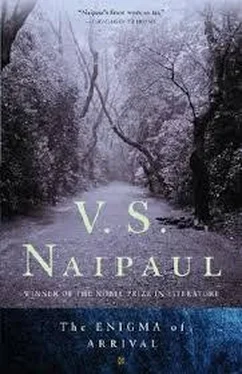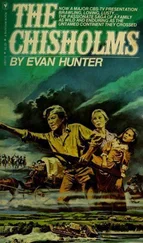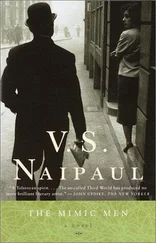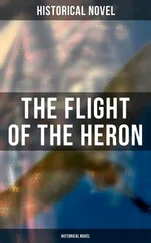V. Naipaul - The Enigma of Arrival
Здесь есть возможность читать онлайн «V. Naipaul - The Enigma of Arrival» весь текст электронной книги совершенно бесплатно (целиком полную версию без сокращений). В некоторых случаях можно слушать аудио, скачать через торрент в формате fb2 и присутствует краткое содержание. Год выпуска: 2012, Издательство: Picador, Жанр: Современная проза, на английском языке. Описание произведения, (предисловие) а так же отзывы посетителей доступны на портале библиотеки ЛибКат.
- Название:The Enigma of Arrival
- Автор:
- Издательство:Picador
- Жанр:
- Год:2012
- ISBN:нет данных
- Рейтинг книги:3 / 5. Голосов: 1
-
Избранное:Добавить в избранное
- Отзывы:
-
Ваша оценка:
- 60
- 1
- 2
- 3
- 4
- 5
The Enigma of Arrival: краткое содержание, описание и аннотация
Предлагаем к чтению аннотацию, описание, краткое содержание или предисловие (зависит от того, что написал сам автор книги «The Enigma of Arrival»). Если вы не нашли необходимую информацию о книге — напишите в комментариях, мы постараемся отыскать её.
The Enigma of Arrival — читать онлайн бесплатно полную книгу (весь текст) целиком
Ниже представлен текст книги, разбитый по страницам. Система сохранения места последней прочитанной страницы, позволяет с удобством читать онлайн бесплатно книгу «The Enigma of Arrival», без необходимости каждый раз заново искать на чём Вы остановились. Поставьте закладку, и сможете в любой момент перейти на страницу, на которой закончили чтение.
Интервал:
Закладка:
The cows themselves eventually disappeared. Some would have been sold; but whether sold or not, what would have happened to them would have been what always happened to cows when their time was judged to have come: batches of them were regularly taken off in covered vans to the slaughterhouse.
I had seen the cows on the hillsides against the sky, heads down, grazing, or looking with timorous interest at the passing man. And they had seemed like the cows in the drawing on the label of the condensed-milk tins I knew in Trinidad as a child: something to me as a result at the very heart of romance, a child’s fantasy of the beautiful other place, something which, when I saw it on the downs, was like something I had always known. I had seen the big eyes, the occasional mild stampede of the herd as, within their pasture, they had followed the walking man, thinking he had brought them something tasty or was to lead them to something they had been trained to like. I had seen the big, wet, black noses, the fly-repellent in the metal sachets clipped to the ears, which they flapped like heavy fans. One sees what one sees. Harder to imagine, unreal, what one doesn’t see.
It had taken me some time to see that though milk came from cows that had dropped calves, no calf was to be seen, except very sick ones: little, seemingly fluid sacks of black and white or brown and white on straw, creatures still seeming fresh from the womb. And no cow with its calf. No lowing herd winding o’er the lea here, as in Gray’s “Elegy”; no “sober” herd lowing to meet their young at evening’s close, as in “The Deserted Village.”
Pictures of especial beauty at one time, those lines of poetry, matching the idea of the cows on the condensed-milk label. Especial beauty, because (though I knew that “sober” well — lovely, apt word — and knew the ritual of bedding down cattle for the night) we had no herds like that on my island. We didn’t have the climate, the pasture; the island had been developed for the cultivation of sugarcane. But there were cattle. Some members of my family, like other country people, kept cows, one or two, for milk, for love, for religion.
We were at the very end of the old Aryan cow worship, the worship of the cow that gave milk, without which men’s life would have been harder and in some climates and lands impossible. This worship was something our grandfathers had brought with them from peasant India; when I was a child, we still honored the idea for its own sake, as well as for its link with the immemorial past. Among us, the new milk from a cow that had just calved was almost holy. A special sweet was made from this very rich milk and sent by the cow’s owner to friends and relations, sent in very small portions, like a consecrated offering from a religious rite.
Our few cows (perhaps like Gray’s or Goldsmith’s herds) were poor things compared with the healthy, big animals on the downs. But these animals on the downs, even with their beauty, were without the sanctity, the constant attention of men, which as a child I thought cows craved. These cows in railed pastures or meadows had numbers scored into their rumps. No sanctity at birth, and none at death; just the covered van. And sometimes, as once in the derelict, mossy yard at the back of Jack’s cottage, there were reminders of assisted insemination or gestation going wrong: when for some days, isolated from the animals that had all come out well, oddly made cattle were penned up there, with that extra bit of flesh and hair (with the black and white Frisian pattern) hanging down their middle, as of cow material that had leaked through the two halves of the cow mold.
And now, with the disappearance of the cattle, there came to the old and new lanes and ways of the downs around the farm (whose life might have seemed to the visitor unchanging and ritualized) a moment of stasis, suspense. There had been great activity; now there were more ruins than ever.
The manor in whose grounds I lived, so many of its rooms shut up; the gardens of the manor, the forested orchard; the children’s house there, with the conical thatched roof, the thatch rotting, the thick stack of the damp reeds slipping out of the wire netting in one place, creating the effect at the bottom of a diagonal slicing of the reeds; the squash court that was not squash court or farmhouse; the old granary with the double pyramidal roof.
Beyond the renovated church, the old farm buildings had been taken down and replaced by the prefabricated shed, which was now empty; with the round convex silver mirrors at the entrance to the cow yard as reminders of the traffic that had once been. The pink house with the green-stained thatched roof and the shredding straw pheasant on the roof; its garden now a piece of waste ground. The new barn and the new half-slatted cow shed at the top of the hill with the windbreak of pine and beech, trees which had grown so much since I had first seen them. At the bottom of that hill, the silage pit with the thick timber-plank walls against the excavated hillside, the timber planks stained with creosote; the tires all around, bought in such number from people who dealt in such things, tires worn smooth from many miles on many roads; and the rubble of the excavation, hummocked and chalky white and full of grass and weeds.
And these were set among older ruins. The small old farm building, perhaps from the last century, far to the right at the end of the overgrown track at the foot of the hill; and all the many farm buildings, old or very old, at the back of Jack’s cottage. Along the droveway: the beehives; the house-shaped old rick; the old stone house, ruined walls alone, surrounded by trees which, tall and overhanging the ruin when I had first seen them, were now ten years older: vegetable nature moving on, stone immovable.
And in the walk in the other direction, away from the old Land-Rover run of the old manager: the great Swiss rolls of hay still stacked in the space between the wood — how grown! — and the hill of larks, with the ancient barrows at the top, part of the pimpling of the downs as seen against the sky: those rolls of hay now as black and as earthlike as the older bales that, at the other end of the droveway, had indeed, below their tattered plastic sheeting, turned to earth. Grass to hay to earth.
M Y OWN time here was coming to an end, my time in the manor cottage and in that particular part of the valley, my second childhood of seeing and learning, my second life, so far away from my first.
I had tried almost from the beginning to make myself ready for this end. After the glory and surprise of the first spring on the riverbanks — the new reeds, the water clearing to crystal (“freshing out,” as I learned to say), but this water green and dark with olive-blue suggestions and with illusory depth where it reflected the thick, succulent growth on the banks, and especially below trees — after that first spring I would say: “At least I had a spring here.” And then I said: “At least I had a spring and summer here.” And: “At least I’ve had a year here.” And so it went on, as the years passed. Until time began to telescope, and experience itself began to change: the new season not truly new any more, bringing less of new experience than reminders of the old. One had begun to stack away the years, to count them, to take pleasure in the counting, accumulation.
One autumn afternoon I had a slight choking fit as I walked past Jack’s old cottage and the derelict old farmyard. The fit passed by the time I had got round the corner, cleared the farmyard, and left behind the old metal and tangled wire and timber junk below the beeches. (Not the birches near the fire pit; they were on the other side of the way. These beeches were at the edge of the farmyard, big trees now in their prime, their lowest branches very low, providing a wonderful, rich, enclosing shade in the summer that made me think of George Borrow and his wanderings in The Romany Rye and Lavengro .) Past the beeches and the farm, in the familiar solitude of the grassy way, I began to breathe easily again. Some irritation, something in the air around the farmyard, some passing allergy, I thought, and did nothing about it when I went home. That evening the fit returned. It was like a continuation of the moment near Jack’s cottage; but this time it stayed with me, and within two or three hours I was seriously ill.
Читать дальшеИнтервал:
Закладка:
Похожие книги на «The Enigma of Arrival»
Представляем Вашему вниманию похожие книги на «The Enigma of Arrival» списком для выбора. Мы отобрали схожую по названию и смыслу литературу в надежде предоставить читателям больше вариантов отыскать новые, интересные, ещё непрочитанные произведения.
Обсуждение, отзывы о книге «The Enigma of Arrival» и просто собственные мнения читателей. Оставьте ваши комментарии, напишите, что Вы думаете о произведении, его смысле или главных героях. Укажите что конкретно понравилось, а что нет, и почему Вы так считаете.












